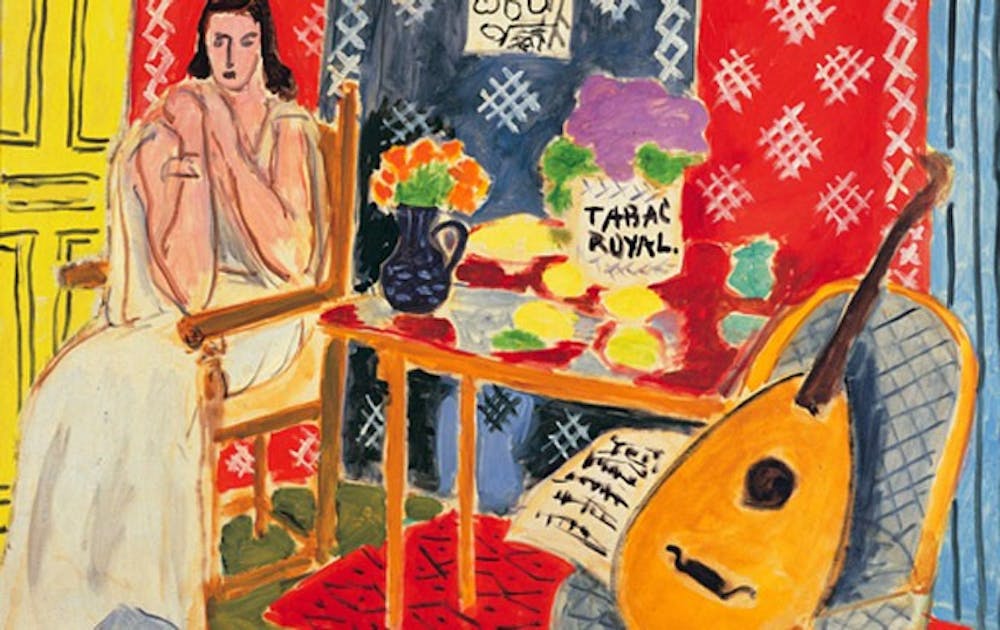In keeping with the Nasher Museum of Art’s reputation of exhibiting the works of high-caliber artists, Henri Matisse now joins past artists Velázquez, Warhol and El Greco as a temporary Durham resident.
The Collecting Matisse and Modern Masters exhibition, which opened November 4 and runs until February 10 at the Nasher, includes more than 50 out of the 3,000 total pieces of the collection of sisters Etta and Claribel Cone. It showcases sculptures, paintings, sketches and other works by Matisse, Picasso, Gaugin, Renoir, van Gogh and more. Additionally, the exhibition contains textiles and decorative arts from around the world as well as photographs and letters chronicling the lives of the sisters as they collected the work of these artists together.
“The way it includes photographs and diaries and jewelry [and] lace and fabric from around the world tells the story of the sisters as people and collectors,” said Wendy Livingston, manager of marketing and communications for the Nasher.
Etta and Claribel Cone came from a wealthy family in Baltimore made successful by a textile empire that their brothers Moses and Caesar built in North Carolina. Their art collection began when the family gave Etta $300 in 1898 to decorate their estate in Baltimore. With this, the sisters’ lifelong devotion to art collecting began. They eventually made yearly trips to Europe to purchase the art.
Gertrude and Leo Stein, who were family friends, introduced the sisters to radical artists at the time like Picasso and Matisse. Eventually they accumulated over 115 pieces by Picasso and more than 500 by Matisse, which helped them achieve praise and recognition by critics and the public. By the time they visited Picasso in 1922—over fifteen years after first acquiring his sketches—they saw an established, famous artist who had come far from the state they first found him in.
“Nowadays, museums and curators would love to discover the ‘next Picasso,’” said Livingston. “Well, they discovered the actual Picasso.”
Sarah Schroth, Nancy Harks Senior Curator at the Nasher, explained that the sisters bought the art to enjoy it personally, hanging them in their adjoining apartments regardless of whether they were the fashionable thing to own in Baltimore. They were very progressive for Victorian-era ladies and were the only ones who collected modern art in their city on that level.
“And in the end, they gave it all to the new Baltimore Museum of Art, very generous indeed,” Schroth wrote in an email. “And they did it as sisters, also unusual.”
Picasso’s gloomy Woman With Bangs hangs juxtaposed to walls filled by sketches of the Cone sisters that were done personally by Matisse. Photographs of Matisse’s Large Reclining Nude in various stages of completion give an intimate prelude to the finished painting itself. This unusual sneak preview emphasizes the profound friendship the Cone sisters had with the artist, who affectionately referred to them as “my Baltimore ladies.” As they were significant sponsors of his work, the sisters were often present for his creative processes. The exhibition also includes correspondence between the Cones and the artists, displaying a shared affection between artist and collector. In a framed handwritten letter in French to Etta, Matisse expresses his condolences after Claribel’s death. Another piece in the exhibition is a sketched self-portrait by Picasso, simply reading “Bonjour Mlle Cone.”
All works of art are on loan from the collection of the Baltimore Museum of Art; the exhibition originally opened at the Jewish Museum in New York City on May 6, 2011. Since then, it has traveled to be presented at the Vancouver Art Gallery in Vancouver, British Columbia, and now to its third and final venue at the Nasher. Livingston noted the exclusive nature of the exhibition through its collection of selected pieces. Once the Nasher exhibition closes on February 10, the pieces will no longer be shown in this unique format.
“You can go to Baltimore and see part of the Cone sisters’ collection, but not in this way,” said Livingston.
As coordinating curator and interim director for the Nasher, Schroth saw the exhibit at the Jewish Museum in New York, where she decided that she wanted to bring it to the Nasher.
“The intelligent curatorial concept is combined with marvelous masterpieces by artists we all know,” said Schroth. “It includes superb examples of Matisse and Picasso in many media, as well other painters who influenced Matisse, their favorite artist—such as stunning canvases by Gauguin, Van Gogh, Courbet.”
The collection also has a unique connection to North Carolina. Because the Cones’ brothers owned textile mills in North Carolina, the ultimate accumulation of the collection can be traced back to the local industry.
“We are highlighting the role the textile industry played in the formation of the collection,” Katie Adkins, assistant curator of exhibitions, wrote in an email. “In addition, textiles are a part of the collection– not only does Matisse include textiles with bright colors and designs in his paintings of interiors, but the Cone sisters also acquired lace and fabrics on trips around the world.”
The exhibition is complemented by additional works collected by the Cone sisters at the Weatherspoon Art Museum at the University of North Carolina at Greensboro, which will be on display until February 17.
“These collections… provide a story and framework around which you can understand the relationship between various works of art and the time period in which they were not only created, but also acquired,” Adkins wrote.
Collecting Matisse and Modern Masters will be on display at the Nasher Museum of Art until February 10.
Get The Chronicle straight to your inbox
Signup for our weekly newsletter. Cancel at any time.

